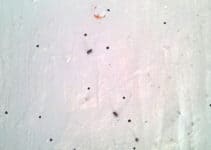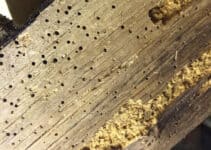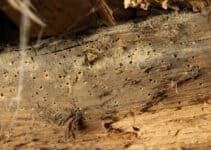Woodworm is a problem that occurs in properties that have large amounts of untreated wood in them. These look like many small nails or pinholes in the wood.
So how do we understand if our property is infested by woodworm? And what does woodworm look like? A surface with a woodworm infestation will have many holes that are 2-5 mm in size. These are oval holes made by adult beetles emerging from them.
Another sign of a woodworm infestation is that the holes are surrounded by frass.
Frass is a kind of powdery dust that is woodworm waste. It is light in colour and looks like wood shavings. This is a surefire sign that a woodworm has occurred in that particular piece of wood.
There are many kinds of woodworm beetles involved in these infestations.
Woodworm occurs in countries all over the world. It is better to spot and catch them before the infestation occurs on a large scale. So let us look at more signs of how to spot such an event.
What Does Woodworm Look Like In The UK?
Woodworm refers to the larvae of wood-boring beetles, not a single species. Visible signs include tiny, round holes in wood surfaces, similar to the holes in a dartboard, and fine, powdery dust known as frass around these holes.
In the United Kingdom, there are more cases of wormwood infestations. This is due to its wet weather that runs all through the year.
The common types of wormwood beetles found here are the Common Furniture Beetle and House Longhorn Beetle.
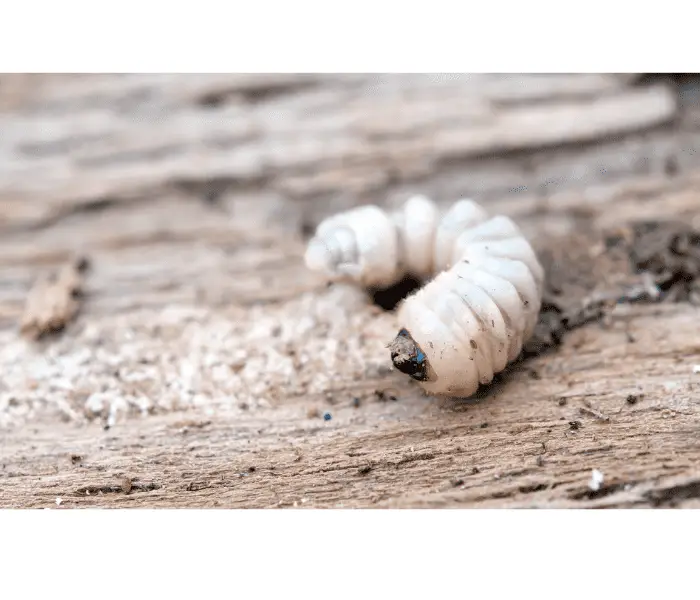
What Does a Woodworm Beetle Look Like?
Woodworm beetles are species of insects whose larvae eat away at wood over time. Although it’s tough to spot woodworm larvae, there are still some signs that will tell you if there is an infestation.
Infestations may cause a crumbly wood texture. Adult beetles may occasionally be seen, but it’s the destructive, worm-like larvae, usually concealed within the wood, that are specifically termed ‘woodworm’.
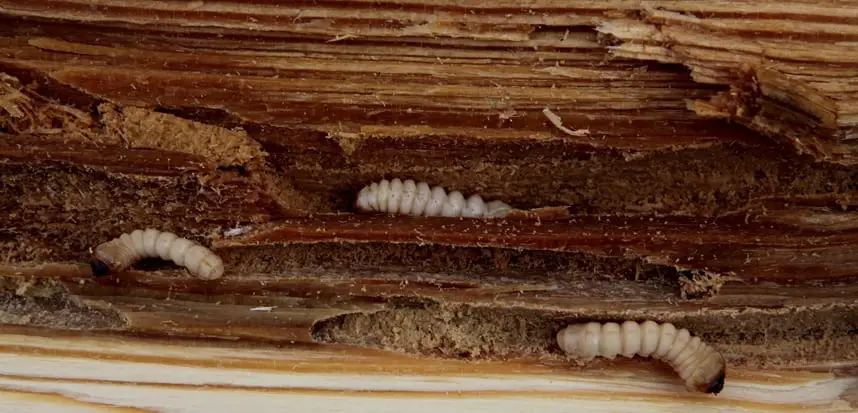
Holes in the Wood
You may have noticed many oval-shaped holes in old, shaky wood in your attic or basement. Woodworms make these holes as they exit from the wood. Different species have different sizes. In large infestations, these holes are pretty close to each other and numerous.
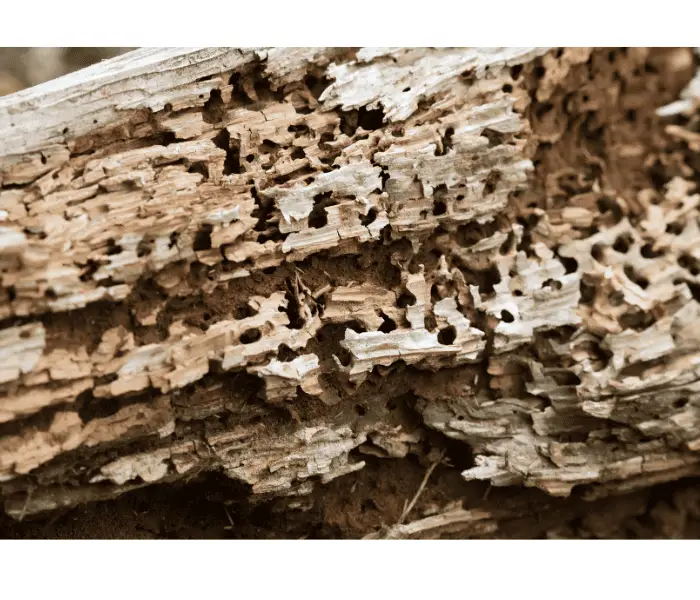
A Lot of Bore Dust or Frass
As woodworms burrow and eat through the wood, they leave behind dusty waste. This is called Frass. The kind of frass left depends on the species of worm.
Some feel moist and sticky, while others are like sawdust or wood shavings. This is another sign of an active infestation.
Frass is usually light in colour and looks like regular dust at first glance.
Presence of Beetles
You can usually see dead woodworm beetle bodies near the infected timber. From May to October, these beetles have their flight season. During this, you can see them slowly come out of the wood as they burrow through.
Tunnels Within The Infected Timber
The final stage of the woodworm infestation is the presence of tunnels. It is also one of the least visible signs. These tunnels are created by these insects as they burrow and make pathways through the timber.
Boards And Joists With Crumbly Edges
Sometimes, we see planks or boards with crumbling sides and edges. These are also signs of a possible infestation. It is better to get it checked as soon as possible.
The crumbling may be due to the damage done by the beetles and can cause structural imbalances.
How Big is a Woodworm Beetle – Woodworm Beetle Size
Woodworm beetles vary in size, depending on the species. Common species like the Furniture beetle (Anobium punctatum) are usually 2.7-4.5 mm in length, while the larger House Longhorn beetle (Hylotrupes bajulus) can reach up to 25 mm.
Are Woodworm Visible to The Eye?
Woodworm are visible to the human eye, but they can be difficult to spot as they spend most of their lives inside wood. Most woodworm beetles are small, ranging from 2 to 8 mm, making them difficult to spot without close inspection. The exit holes they leave behind are easier to notice by the naked eye, as is the fine, powdery frass. However, because of their small size and their tendency to remain concealed, noticing a woodworm infestation often requires close inspection.
Let’s take a look at the different kinds of frass ejected by different species of woodworm:
Common Furniture Beetle
Most infestations are done by this species. They are very attracted to the sap of softwood and European hardwoods. Their frass has a gritty texture, and they leave small piles in the tunnels as they go about burrowing.
Wood-boring Weevils
These weevils are black-brown and have a long snout. They love damp decaying wood such as skirting boards.
Due to the dampness, their frass typically tends towards stickiness. They burrow tunnels around 1 mm in diameter that follow the grain.
Deathwatch Beetle
These wormwood beetles are brown and like oak. They also enjoy feasting on rotten and damp softwoods. Deathwatch beetles tunnel a lot and leave behind bun-shaped frass.
Powder Post Beetle
This reddish-brown beetle is flat and around 8-9 mm in length. They feed on sapwood of beech and oak, which are less than 15 years old. Its frass is also flour-like in texture.
These beetles create holes of 1.5 to 2 mm in diameter.
House Longhorn Beetle
Perhaps the largest of all wormwood beetle species, the House Longhorn Beetle feeds on the sapwood of softwood. Normally seen in England, it causes severe damage giving out lots of frass and thin, brittle wood residue.0
What Does Woodworm Dust Look Like?
Wormwood dust can vary from being gritty or sticky to the touch. Depending on the type of woodworm, this can change—even the wood conditions matter.
If the wood has a lot of moisture, the frass is wet.
What Do Woodworm Droppings look like?
Woodworm droppings, also known as frass, are a clear sign of an infestation. These droppings look like very fine, powdery dust, often the same color as the infested wood.
What do Woodworm Droppings Look Like on Wood?
Frass typically accumulates in and around the tiny, round exit holes created by the woodworm. The consistency of frass is similar to coarse flour. It’s often found in piles or dispersed on surfaces below the infested areas, indicating the presence of these wood-boring larvae.
What Does Dead Woodworm Look Like?
A dead woodworm, is typically difficult to distinguish from a live one unless closely examined. They are small, creamy-white, and curved with a segmented body, typically less than 1 cm in length. Their bodies are soft and they have a dark-colored head.
However, upon death, they might appear dried out, darker in color, or even brittle. Identifying dead woodworm often requires professional pest control expertise.
What Does Woodworm Look Like In Furniture?
Wood typically looks damaged on woodworm infestation. The skirt boards or planks may have crumbling edges. Even the floorboards look weak and make loud creaking noises.
But it is easy to confuse an infestation with wet or dry rot. If such is the case, it is better call a timber specialist to inspect the wood and treat it properly.
Even the age of the property can give you an idea. Older homes and buildings are usually more prone to such infestations.
Remember to check the basements and attics for loose floorboards. Also, check for damp or rotten wood smells as these beetles are attracted to such environments.
What Does a Woodworm Look Like – Summary
The biggest giveaway to how woodworm looks to the naked eye is the presence of oval holes and tunnels in the infected wood.
There are many telltale signs like crumbling furniture or joists as well as the presence of frass. Another thing to look out for is excessive moist or rotten furniture.
Woodworm infestations get pretty ugly if we allow them to remain and fester for years. So it’s better to treat them at the earliest possible point.
Different beetles produce different frass, and you can identify the type of beetle by looking at its frass. You can then treat it appropriately with the correct measures for that particular beetle.
